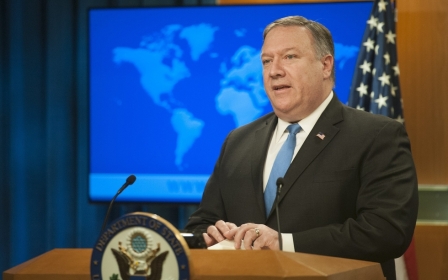Iran to unveil new fighter jet and develop missiles, defying US sanctions

Iran plans to unveil a new fighter jet next week and continue developing missile capabilities as a top priority, the defence minister said on Saturday, defying new US sanctions aimed at curbing Tehran's missile programme and regional influence.
"Our top priority has been development of our missile programme. We are in a good position in this field, but we need to develop it," Brigadier General Amir Hatami was quoted as saying by the Fars news agency on Saturday.
"We will present a plane on National Defence Industry Day, and people will see it fly and the equipment designed for it," Hatami said. Iran celebrates National Defence Industry Day on 22 August.
Iran's navy also said on Saturday that it has mounted a locally built "Kamand" advanced defensive weapons system on one of its warships for the first time, as tensions mount with the US military in the Gulf. The system has been dubbed the "Iranian Phalanx," after an automated machine-gun produced by US firm Raytheon whose heavy bullets shred incoming missiles, Haaretz reported.
Iran has developed a large domestic arms industry in the face of international sanctions that have barred it from importing many weapons. US President Donald Trump in May withdrew the United States from a 2015 accord between Iran and world powers that curbed Tehran’s nuclear activity in exchange for sanctions relief.
Ballistic missile programme
Trump said the deal was deeply flawed as it had not curbed Iran’s ballistic missile programme or reined in its support for proxies in conflicts in Syria, Iraq and Yemen.
US Secretary of State Mike Pompeo this week announced the establishment of the Iran Action Group, a task force to coordinate all of Trump's efforts against Iran.
"The Iran Action Group will be responsible for directing, reviewing and coordinating all aspects of the State Department's Iran-related activity, and will report directly to me," Pompeo said.
Still, Iran has dismissed any direct talks with Washington to resolve the issues raised by Trump. Earlier this week, Iran's Supreme Leader Ayatollah Ali Khamenei banned holding any direct talks with the US. "With better management and planning we can resist the sanctions and overcome them," Khamenei said.
The Tasnim news agency reported on Saturday that the Iranian army has also extended the range of weapons mounted on its helicopters to 12km, citing Yousef Qorbani, commander of the army’s airborne division. Iran is among the few countries with night-vision systems for its military choppers, Qorbani said.
Iran unveiled in 2013 what it said was a new, domestically built fighter jet, called Qaher 313, but some experts expressed doubts about the viability of the aircraft at the time.
Iran's functional air force has been limited to perhaps as few as a few dozen strike aircraft, either Russian or ageing US models acquired before the 1979 Iranian revolution.
Iranian Navy Commander Rear Admiral Hossein Khanzadi said on Saturday that "coastal and sea testing of the short-range defence Kamand system were concluded successfully, and the system was mounted ... on a warship and will be mounted on a second ship soon," the Tasnim news agency reported.
Iran’s Revolutionary Guards said earlier this month it held war games in the Gulf aimed at "confronting possible threats" by enemies.
The US military’s Central Command said it had seen increased Iranian naval activity, extending to the Strait of Hormuz, a strategic waterway for oil shipments the Revolutionary Guards has threatened to block.
One US official, speaking to Reuters on condition of anonymity, said possibly more than 100 vessels were involved in the drills, including small boats.
US officials told Reuters the drills appeared designed to send a message to Washington, which is intensifying economic and diplomatic pressure on Tehran but has so far stopped short of using the military to more aggressively counter Iran and its proxies.
Middle East Eye propose une couverture et une analyse indépendantes et incomparables du Moyen-Orient, de l’Afrique du Nord et d’autres régions du monde. Pour en savoir plus sur la reprise de ce contenu et les frais qui s’appliquent, veuillez remplir ce formulaire [en anglais]. Pour en savoir plus sur MEE, cliquez ici [en anglais].




